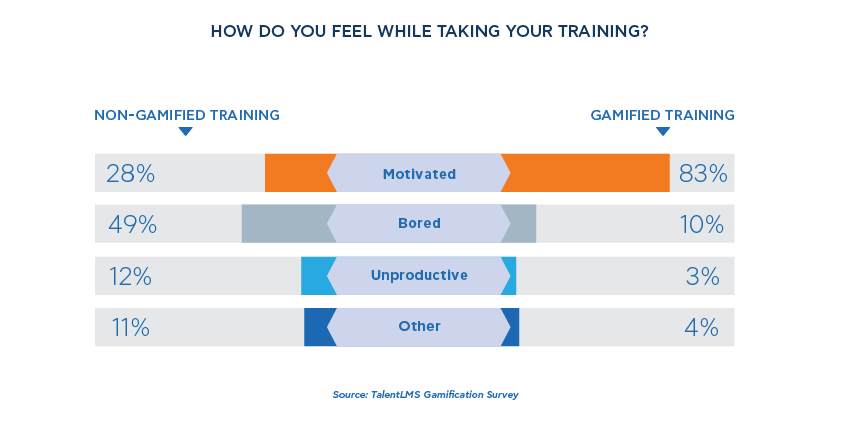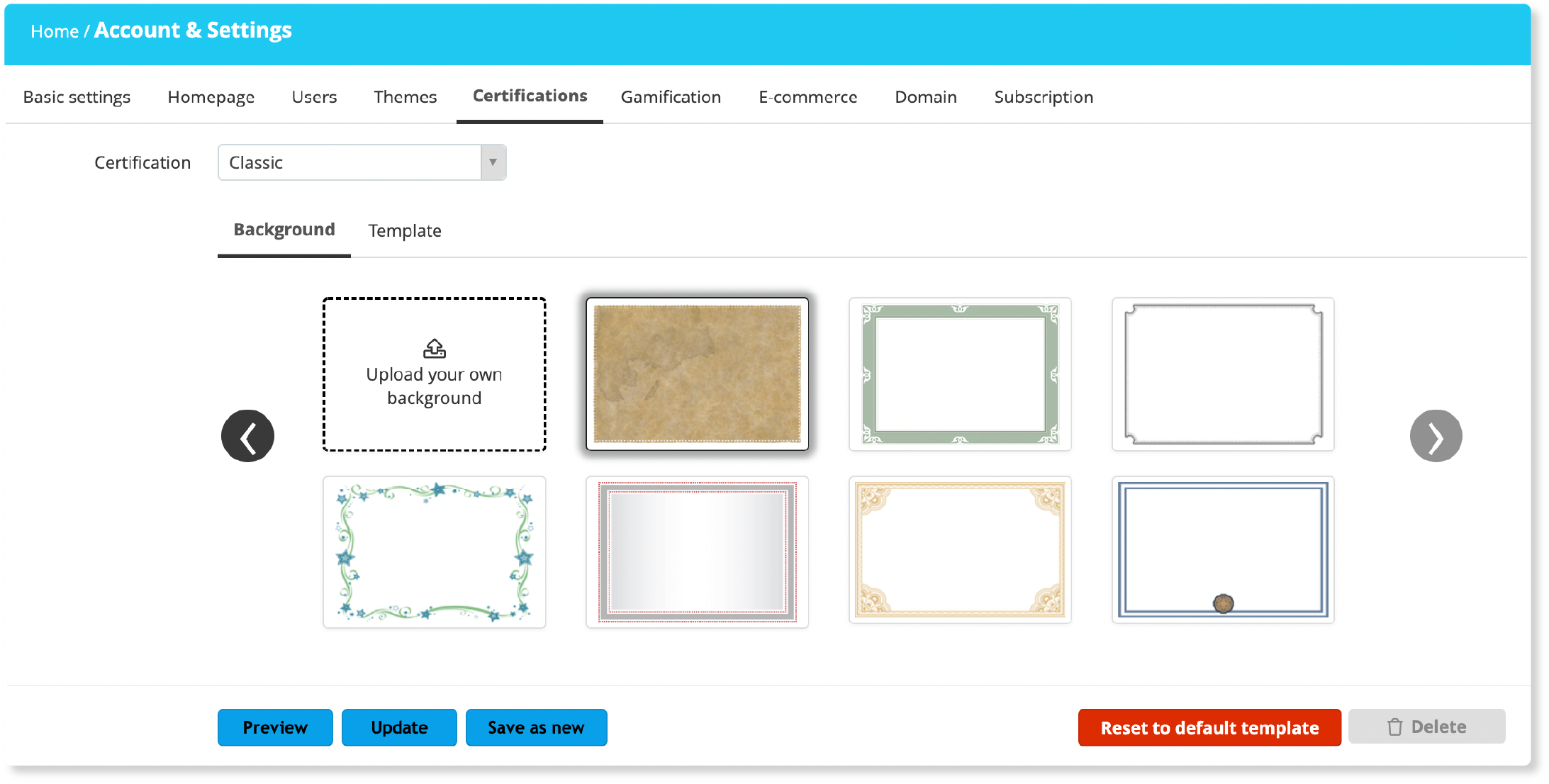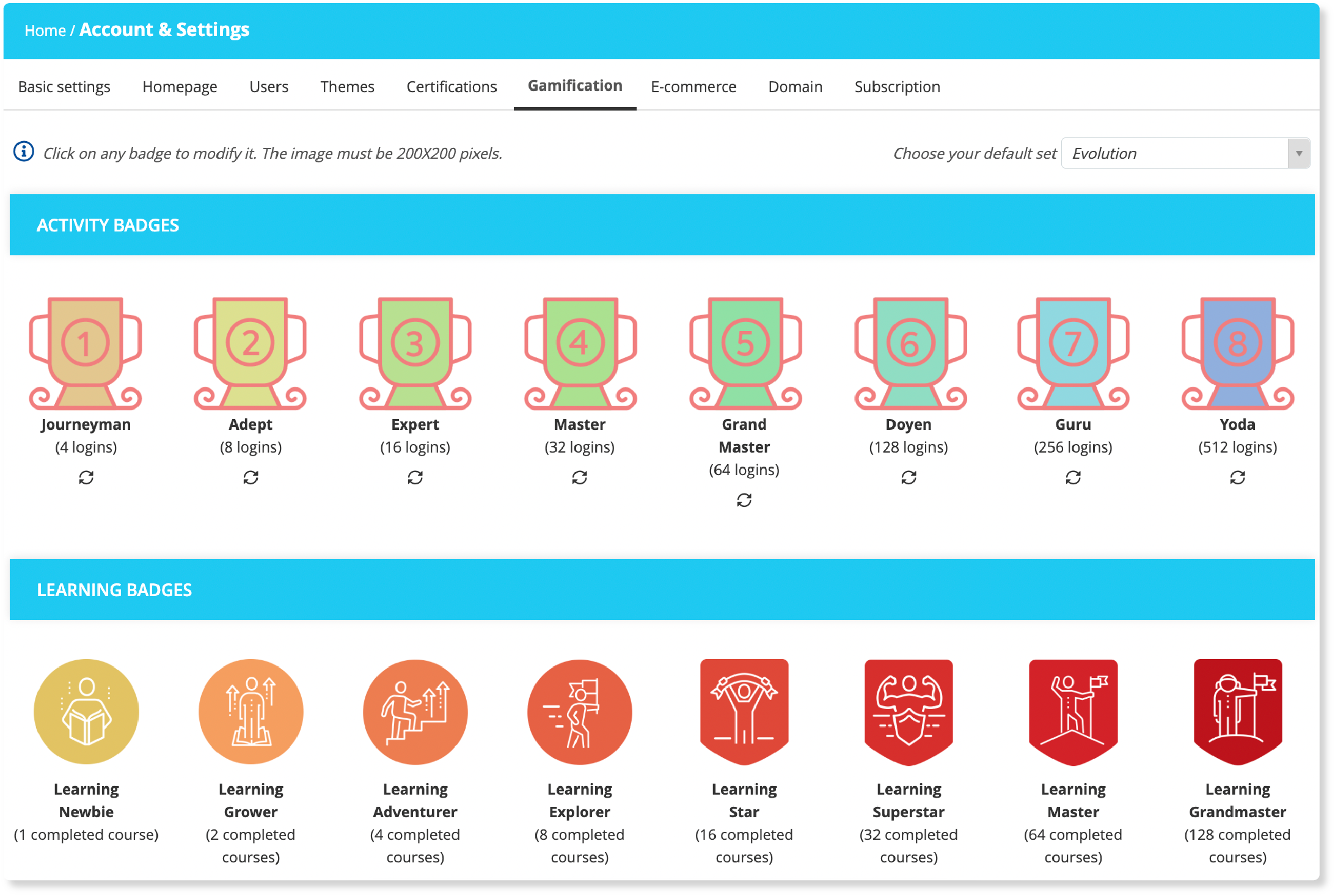- What are certifications and badges and how can they motivate learners?
- Additional benefits of badges and certifications
- Choose the right platform: Badges and certifications made easy
- How to build an LMS rewards program: A step-by-step guide to badges and certifications
- How to incorporate badges and certifications in learning
- Getting it right
- Reap your own rewards
You’ve won a gold medal for [insert favorite sport] in the Olympics. During the award ceremony, standing high on the podium, it’s placed around your neck. Crowds cheer, cameras flash. The medal’s heavy. You can feel the weight of the gold and see it glittering in the sun. Having that medal matters. It matters a lot. And being able to share your achievement with others matters, too.
But the pride you feel goes deeper. It’s what the medal symbolizes that carries the most weight: Hard work, dedication, commitment, and achievement.
It may not be the Olympics, but in the world of eLearning, reward and recognition matter, too.
Having something tangible that can be shared, but also symbolizes attainment and credibility, is important for a number of different reasons. In this article, we look at training rewards in eLearning. Specifically, the use of training badges and certifications to motivate and reward learners.
On the surface, it’s a subject that seems pretty straightforward. But to achieve results, gain engagement, and maximize impact, there’s actually a lot to consider.
Time to step off the podium and find out more.
What are certifications and badges and how can they motivate learners?
In the world of eLearning, badges and certifications act as digital credentials. They’re a form of physical proof that can be displayed, shared, and verified online. But their value is also in what they symbolize. Whether it’s a certificate confirming credentials such as skills achieved and assessments passed. Or a badge acknowledging activity milestones, or contribution to a course or project.
Since COVID-19 and the rise in remote working and virtual networking, digital credentialing has become more common. But is using digital credentials such as training badges and certifications the best way to motivate learners? And, if so, how and why?
What’s in it for me?
Faced with a task to complete or an action to perform, most people want to know what they’ll gain from the activity. Fair enough. After all, if you’re putting effort into something, it’s natural to want something in return. Some rewards (intrinsic rewards) will emerge organically from the activity or task. The individual will feel or experience the benefits within themselves. In training, for example, there’s usually a skill, competency, or behavior that participants will automatically acquire.
But sometimes, this may not be enough to spark true engagement throughout. Or motivation to engage in the first place.
Sometimes you need extrinsic rewards. These are external forms of recognition.
Here’s where training badges and certifications come in. Badges and certifications qualify an individual’s achievements in a tangible way, providing formal rewards and recognition for efforts invested.
How did I do?
Peer-to-peer approbation is a powerful motivator. And these digital credentials offer learners tangible and physical rewards they can showcase. Employees can share them internally within your organization but also externally with industry contacts and others in their network.
They can also see where they stand compared to their peers.
Used in the right way, badges and certifications can motivate learners by encouraging a friendly rivalry between participants. Leaderboards and points can also be used to support this. A healthy sense of competition can be a powerful tactic when it comes to eLearning. A form of gamification, awarding badges for finishing key tasks makes training more enticing and prompts people to come back to continue a course.
Let’s have a bit of fun!
Training badges and certifications make learning more enjoyable, too. Sometimes training (particularly mandatory training) can be perceived as a chore. Gamification in the workplace and the use of rewards such as training badges and certifications create an element of fun that transforms learning from a task to be completed into an activity to be experienced.
Fun fact: Based on a TalentLMS survey, 83% of those who receive gamified training feel motivated, while 61% of those who receive non-gamified training feel bored and unproductive. Ergo: Fun works.

Engage your learners with a gamified platform
Turn training into an addictive, habit-building game with TalentLMS.
Easy to use, easy to customize, easy to love.
Additional benefits of badges and certifications
As we’ve seen, badges and certifications can help motivate learners in a number of ways. But their benefits don’t end there. Let’s take a look at some of their other advantages:
Demonstrate value
Creating and providing rewards such as training badges and certifications shows employees you care about their career development and success. It elevates training by making it a reciprocal arrangement where both parties are mutually invested in the activity and the outcome. It shows your employee you value them. And that you value learning.
Measure progress
Attaching certifications and badges to courses is a good way to evaluate knowledge and attainment. Using this data, your HR team can generate reports and share achievements with stakeholders across the business. They can also evaluate areas of success. And pinpoint areas that may need improvement or a different approach to grow motivation.
Track compliance
It may not be the most exciting collection of courses in your portfolio, but compliance training matters. Unlike other L&D programs, it also requires an ongoing commitment. Most compliance courses have a sell-by date of a year or so. With the expiration data stored in your system, dated digital certifications are a useful way of tracking the status of your compliance courses. And activating reminders.
Make the right hire
Digital training badges and certifications are useful internally. But also have relevance outside your organization. Used by hiring teams, they’re objective proof that a candidate has a particular skill or area of knowledge. And are a good way of shortlisting candidates. They’re also useful when hiring internally. For example, when you want to promote current employees or transfer them to another role or department.

Choose the right platform: Badges and certifications made easy
Training rewards such as badges and certifications carry weight. They’re valued by both you and your employees. So you need to make sure they’re administered correctly. This can take time for your HR team and instructors. And can become increasingly complex with multiple courses and employees to manage. The answer is to choose an automated training platform or Learning Management System (LMS) that can do it all for you.
So, when it comes to LMS rewards, what should you look for? Tick all of these off and you’ve chosen well:
- Gamification features such as badges, certifications, leaderboards, levels, and points.
Tip: If there’s a reward feature, use it to turn your users’ virtual awards into tangible ones. - Customization options so you can add your own background design, date range, and wording.
Tip: Making your reward program consistent, coherent, and unique to your brand creates a sense of unity among learners. - One-click, automated LMS awards, added to each learner’s profile. And automated notifications for you and your learners.
Tip: Look for notifications that include course completed, badge awarded, certificate achieved, certification expired, expiration date coming up. - A “Progress” tab so learners can keep track of their certifications, badges, and other awards.
Tip: This boosts motivation and supports healthy competition. - A clear analytics dashboard to track how your gamification program performs against the goals you had set.
Tip: Track factors like the number of employees who participate in the program, how many complete the goals, and how much overall job performance improved during or right after the gamification program.
How to build an LMS rewards program: A step-by-step guide to badges and certifications
With a platform like TalentLMS, you can set up a reward program using training badges and certifications in a few clicks and then leave it to run itself. Here’s how:
Using certifications
Step 1. Create custom certificates
Step 2. Assign each certificate to a course
Step 3. Give each certificate a duration
Step 4. Set up an automated notification of when the course needs to be retaken (if applicable).

Using badges
Step 1. Turn gamification on
Step 2. Choose what to award your badges for (logins, completed courses, passed tests, comments contributed, or surveys completed, for example)
Step 3. Define the criteria for meeting the milestones in each category (for example, the learner receives a badge at each of the following stages: 4, 8, 16, 32, 64, 128, 256, and 512 logins)
Step 4. Create custom badges

Tip: Remember to promote your reward plan internally. Communicate the value of the training as well as the recognition scheme. And make the rules and criteria clear for everyone.
How to incorporate badges and certifications in learning
So far, we’ve talked in general about using training badges and certifications in training. Let’s have a look at some examples of how it might work in practice.
People respond differently to different types of training. They’re motivated by different things. And contribute in different ways. The best way to motivate learners is to reflect this in your training rewards program. This means recognizing a combination of the following:
Knowledge achieved
A big part of the success of your training lies in your employees knowing something after that they didn’t before. Encourage this by awarding badges to those who achieve a certain number of certifications.
But remember to focus learning on what’s relevant and useful to each learner. Your employees should be taking courses that stretch them and build skills relating to their job. Not courses that they find easy and that they’re only taking to boost their tally.
Social interactivity and communication
Acquiring knowledge isn’t everything. Sharing knowledge and ideas is just as important. Recognize this in your reward program by offering badges for those who engage and interact with their coworkers.
You could, for example, track social posts and comments and allocate awards to people who post the most helpful tips or resource links. Or award badges to employees who answer the most questions on an online discussion forum. Again, keep it focused on the topic.
Supporting skills
Sometimes soft skills emerge throughout the training process that aren’t tied to the course’s specific outcome. Leadership, management, and teamwork are a few examples of these. Find a way to reward those who make a positive contribution in these areas.
Progress
Some of your employees won’t be natural achievers or motivated by high levels of attainment. Out of all of your learners, it’s this group that may need the most encouragement to continue with their training. To target employees who may be struggling with skill and performance gaps, design awards around progress made, as well as courses passed.
Course participation levels
Enthusiasm and commitment count for a lot. As well as boosting individual attainment, employees who regularly engage with training help create a culture of learning that inspires others. So weave this into your training rewards program by allocating badges to learners who regularly log in and participate in their eLearning.
Remember to include informal social learning experiences, too, if you can.
Ambition and interest
Training needs to be focused. But it doesn’t need to be limiting. Use training rewards like badges to recognize employees who learn new skills or take part in training designed for different positions or departments.
Learner-generated content
If you’re lucky, you’ll have employees who take training into their own hands, creating learning materials for others to benefit from. A short video demonstration on how to complete a task, for example. Or, an audio presentation about a new product release or feature.
As well as enriching your training resources, learner-generated content also reduces training costs. By using training rewards, you’ll encourage more people to follow suit. Which is good news for your employees and your business.
Looking for efficient ways to motivate learners?
Create custom training certificates and badges in minutes with TalentLMS.
The training platform that users consistently rank #1.
Getting it right
Badges and certifications bring big benefits to your training program. But they can also compromise it. Focus too much on the rewards and your learners can lose sight of the main learning intention. They may rush through courses simply to gain badges or certificates. And not actually engage with the learning material or absorb or retain any information. Rewards can also send out mixed messages. For example: Is this going to be a valuable course? Or is it going to be a laborious chore that requires an incentive to make completing it worthwhile?
If they’re awarded too liberally, or without being linked to a meaningful achievement, they can destroy the credibility of the course. And devalue the currency of the rewards themselves. Rewards may also not be right for every type of training. There are some courses where the rewards will be obvious from the outset and then emerge organically from the activity or task. With these intrinsic rewards, the individual will feel or experience the benefits within themselves.
But sometimes, this may not be enough to spark true engagement throughout. Or motivation to engage in the first place. Sometimes you need extrinsic rewards or external forms of recognition. And that’s when you call on your training badges and certifications.
Reap your own rewards
Of course, none of this should put you off using training rewards. Quite the opposite, in fact. Because with these caveats in mind, you’re well-armed to address them. All it takes is a little careful planning and thought to get the approach right. Use them wisely. Use them well. And training badges and certifications will bring their own rewards.
| Tags: Employee Engagement,Employee Training,Gamification,Training Certificates



![Cybersecurity Training Email Template [5 Free, Downloadable Examples]](https://images.www.talentlms.com/blog/wp-content/uploads/2023/01/TLMS_20230116_1200x628-1.png)